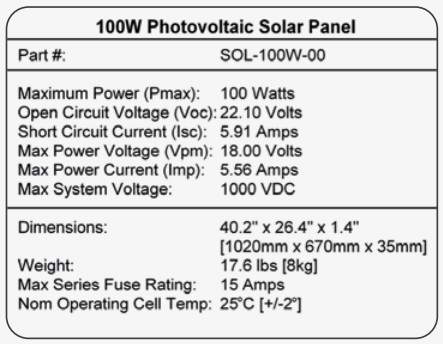Solar system installation requires a special guide because most of the required components are delicate and costly. Using the wrong size or rating of any solar PV component might reduce the efficiency of the entire system or even damage some of the components. You need to know the required size and rating of solar panels, charge controllers, batteries, inverters and cables for any solar installation work. All these must be calculated and recorded to help you know the total cost of purchasing these solar components and also the installation cost. In this article, you will learn how to determine the perfect size and ratings of all the components required for solar PV design and installation works.

Load Analysis/Estimation
It is always good to do a thorough load analysis of all the electrical components which the solar system will power. This will help you know the exact ratings of each of the solar components to buy.
For the sake of this tutorial, I will analyse the load in my one room apartment (self-content). The loads are as follow:
- 1 ceiling fan: 65W
- 4 energy bulbs @ 8W each: 32W
- Dell laptop (old model): 100W
- HP laptop: 60W
- 1 solar fridge: 80W
- 1 TV set: 100W
- Total estimated load: 437W
- Required daily backup time for the solar batteries: 12 hours (mainly from 8PM to 6AM)
I will be referring to the above simple load analysis/ estimation in this tutorial article.
See:
- Pros, Cons & Uses of Solar PV Energy Technology
- Different Solar PV Inverter Technologies for Grid & Off-Grid Connections
Inverter/UPS Rating
It is always advisable to ensure that the power rating of your inverter/UPS to be greater than your total load by 25%. This extra 25% will cover both the electrical loss and for future load you might add.
This means that your inverter/UPS power rating should be = 125% of your Total Load
= 1.25 x Total Load
So, in the case of my room, the minimum required inverter rating (in Watts) = 1.25 x 437
= 546.25W approximately 550W = 0.55KW
NOTE: Inverter power is usually rated in VA or KVA.
Power in VA = AC voltage in Volts x AC current in Amperes
Power in KVA = Power in VA / 1000
Power in Watts = AC voltage x AC current in Amperes x PF
Where; PF = Power Factor, usually 0.8 (standard for house) or 0.85. It is the ratio of real (active or true) power, P (usually expressed in KW) to apparent power, S (usually expressed in KVA). That is KW/KVA. Power factor tell you how efficient an electric energy is. So a power factor of 0.8 implies that the efficiency of electricity supplied by the utility companies is 80%.
The difference between apparent power, S and real (active or true) power, P is the Reactive power, Q, usually expressed in KVAR. Reactive power is part of the electric energy that the utility companies supplied, which was wasted or lost as heat or as vibration. It does not do any active work.
Power in KW = Power in Watts /1000
Also, Power in W = Power in VA x PF
This implies that Power in KW = Power in KVA x PF
Making Power in KVA the subject of the formula;
Inverter Power in KVA = Power in KW / PF = Total Load in KW / PF
So in the case of my room where the total load is 550W, which is 0.55KW (that is 550/1000), using a power factor of 0.8, the rating of the inverter in KVA needed is
= 0.55 / 0.85 = 0.65KVA, which approximately 1KVA.
So I will need to buy at least 1KVA sine wave inverter. 1KVA inverters are usually meant for 12 V solar systems. That means that the total or effective voltage of the batteries should be 12V also.
But from the least number of batteries needed to meet up with my estimated backup time, it means I will need a 24 solar system. So I will buy 1.5KVA/24V solar inverter. Then I will make sure that the total or effective voltage of my solar batteries is 24V also.
Estimated Backup Hours of Solar Batteries
Backup hours means the number of hours a given battery or set of batteries can sustain a load.
The estimated backup time of a battery or set of batteries is given by
= (Energy of One Battery (Wh) x Number of Batteries)/(Total Load); expressed in Hours
Required Number of Batteries
In the case of my room, the required backup time for the solar batteries (in hours) = 12 Hours
Assuming I decide to buy 200Ah/12V solar batteries for the installation.
Note: A 200Ah/12V solar battery can supply 200A current at 12V for 1 hour.
Recall; Electric charge, Q = Current (I) x Time (t) = I x t
Where; Q is expressed in Coulombs, I is expressed in Amperes (A), t is expressed in Hours (h)
So, this is how the rating system (Ah) of solar batteries came about. The unit Ah tells you the maximum quantity of charge a battery can supply per hour.
Also recall; Electrical Power, P = Current (I) x Voltage (V) = I x V
Therefore the electrical power of a 200Ah/12V solar battery = 200 x 12 = 2400W or 2400Wh (in terms of electrical energy)
Expressing in terms of electrical energy, E = Electrical Power (P) x Time (t); where t is expressed in hours.
2400W expressed in terms of electrical energy will be 2400Wh.
Therefore a 200Ah/12V battery can carry a load of 2400W for 1 hour.
So if the number of hours a 2400Wh battery can carry a 550W load is
= (2400Wh)/(550W) = 4.36 Hours; approximately 4 Hours 21 Minutes 36 Seconds
For a backup time of 12 hours, the number of 200Ah/12V batteries needed is
= (12 Hours)/(4.36 Hours) = 2.75; approximately three 200Ah/12V batteries
So, in the case of my room with an estimated backup time of at least 12 hours, and a total load of 550W, I will need at least three 200Ah/12V solar batteries.
But since I have decided to buy a 1.5KVA/24V inverter, I need to buy four 200Ah/12V solar batteries. Then I will connect the first two batteries in series, also connect the other two in series. And finally parallel them to give me an effective voltage of 24V.
Another option is to buy two 200Ah/12V solar batteries and then connect them in series to give you an effective voltage of 24V. But note that two 200Ah/12V solar batteries will not meet up with my estimated backup time (12 hours).
I will explain the different ways to connect your solar batteries and panels later in this article.
NOTE:
The general formula for calculating battery power in Wh is
= Battery capacity in Ah x Battery Voltage in V x Number of batteries
General formula for calculating inverter backup time is
= (Battery capacity in Ah x Battery Voltage in V x Number of batteries)/(Total connected load in W)
The general formula for calculating battery capacity in Ah is
= (Battery backup in h x Connected load in W)/Battery voltage in V
Different Solar Battery and Solar Panel Connection Types
There are 2 main ways to connect your solar batteries and solar panels. They include:
- Series connection
- Parallel connection
For Series Connection: The effective or total voltage is simply the algebraic sum of the voltage of the individual components (solar panels or solar batteries). While the effective or total current is same as the current that flows through one of the components.
That is; VT = V1 + V2 + V3 + … + Vn
IT = I1 = I2 = I3 = In
For Parallel Connection: The effective or total current is simply the algebraic sum of the current of the individual components (solar panels or solar batteries). While the effective or total voltage is same as the voltage of one of the components.
That is; IT = I1 + I2 + I3 + … + In
VT = V1 = V2 = V3 = Vn
Note that in both series and parallel connection type, the total power or wattage of the components (solar batteries and solar panels) is the algebraic sum of the individual components.
That is; PT = P1 + P2 + P3 + … + Pn
Also note that the 40% power loss during battery charging is neglected here.
The above formulas (both for series and parallel connection types) are correct if and only if each of the connected components have the same rating, both in terms of voltage and current.
NOTE:
There is a special type of connection in which both series and parallel connection types are applied. This special connection type is called Series-Parallel connection type. This connection type is applied in cases where much numbers of batteries or solar panels are required (usually four and above). If connecting these number of batteries in parallel or in series will cause the effective voltage of the battery banks to go above or below the inverter working (system) voltage, then this connection type is applies to make the effective voltage of the battery bank equal to the inverter system voltage. The same applies to the solar panels.
When applying this Series-Parallel connection to your solar batteries or solar panels, make sure that the total number of the components in which you are applying this special connection type to is even number. For example, you can connect 4 panels or batteries (pair them 2 in series, then you parallel them), 6 panels or batteries (connect 2 groups of 3 in series, then you parallel them), etc.
In the case of my room, since I need four 200Ah/12V solar batteries, I will apply the series-parallel connection type to ensure that the effective voltage of my battery bank does not exceed 24V, which is the working voltage of my 1.5KVA inverter.
Here is a complete guide on the different ways to connect solar panels and batteries.
Estimated Charging Current for the Batteries
The estimated battery charging current should be one-tenth of the total or effective battery capacity in Ah. It is expressed in Amperes (A).
That is; the estimated battery charging current is
= (1/10) x Total Capacity of the battery bank in Ah
= 0.1 x Total Capacity of the battery bank in Ah
In the case of my room, since I am using four 200Ah/12V solar batteries, my total battery capacity will be
= 4 x 200Ah = 800Ah
So the estimated battery charging current will be
= 0.1 x 800 = 80A
Estimated Charging Time for the Batteries
The estimated time (in hours), T for the battery bank is
= (Total Capacity of the battery bank in Ah)/(Charging current in A); expressed in hours
= (Ah)/(A)
In the case of my room, the total capacity of my battery bank in Ah is 800Ah (that is 4 x 200Ah). And my charging current calculated previously in this article is 80A.
The estimated charging time for my battery bank will be
= 800 / 80 = 10 Hours
Note that about 40% power loss occurs during charging of solar batteries.
Taking into account this 40% power loss,
The capacity of my battery bank will be assumed to be
= 1.4 x Actual total battery bank capacity in Ah
= 1.4 x 800 = 1120Ah
Assuming charging current to be constant; in the case of my room, it is 80A,
The estimated charging time for my battery bank will be
T = 1120 / 80 = 14 Hours
Note that this is just an estimated value. The charging time depends on the type of charge controller used (it is lesser when MPPT charge controllers are used). Also, it will be lesser if you are using the mains to charge the batteries via the inverter charging circuit.
Required Number of Solar Panels and the Best Connection Type
We will consider two scenarios here.
Scenario 1: No Load Connected (Only for Charging the Batteries Bank)
Here, the loads are not connected to the solar system during the charging hours of the battery banks.
From the DC power formula; P = IV
Where; I = charging current, V = effective voltage rating of the battery bank
In the case of my room: charging current, I = 80A; effective voltage of the battery bank = 24V
So P = 80 x 24 = 1920W
Assuming I wish to buy 300W/24V solar panels, the number of solar panels needed is
= 1920 / 300 = 6.4; that is approximately 6
Therefore at least six 300W/24V solar panels will be needed.
Scenario 2: Load is Connected to the Inverter, as the Batteries Bank is Being Charged
Here, as the battery is being charged by the solar panels, it is also powering loads via the inverter.
In the case of my room, assuming a total load of 250W is connected to the inverter, and the solar panel is also expected to fully or properly charge the battery bank at the same time,
The total load is = 250W + (80 x 24) = 2170W
Assuming I wish to buy 300W/24V solar panels, the number of solar panels needed is
= 2170 / 300 = 7.23; that is approximately 7
Therefore at least seven 300W/24V solar panels will be needed.
Note that with the help of MPPT charge controller, you can use about six 300W/24V solar panels in this second scenario. But if you wish to use a PWM charge controller, then you will need at least seven 300W/24V solar panels.
For both scenarios, you will apply series-parallel connection type to ensure that the maximum permissible current for the charge controller is not exceeded.
NOTE:
It always advisable to use even number of both batteries and solar panels, except when you are using a 1KVA/12V inverter system where the use of more than one 12V battery is not supported. Using even number of both solar batteries and solar panels allows for easy voltage and current manipulation, to ensure that the highest permissible value of both voltage and current is not exceed, especially for inverter and charge controller.
To learn the step by step guide for calculating the right size and ratings of solar components for any solar PV design and installation, check out this eBook on Amazon: Complete Solar PV System Installation Guide. It contains DIY guides for installing grid and off-grid solar PV systems, how to build solar-powered electric cars and the various ways to make money from the solar energy sector.
How to Read a Solar Panel Name Plate
A nameplate is a tag or label usually found on the body of components or gadget that describe some of the features and key information about the gadget. You need to understand some of the values on the nameplate of a solar panel before you can perform solar panel calculations. Below is a screenshot of a 100W solar panel.

- Maximum Power (Pmax) means the maximum wattage of power it can deliver. In the case of the above solar panel name plate, it is 100W.
- Maximum Power Voltage (Vpm) tells you about the maximum output voltage of the solar panel. In the case of the above solar panel name plate, it is 18.0V.
- Open Circuit Voltage (Voc) means the voltage without load.
- Maximum Power Current (Imp) means the maximum output current.
- Short Circuit Current (Isc) means the current that will flow when a short circuit is created in the solar panel (usually occurs when the positive and negative terminals of the solar panel are joined together, which should be avoided). In some solar panel name plates, it is specified as Maximum Over Current Protecting Rating in Amperes.
- Maximum System Voltage which tell you the maximum DC voltage limit when the solar panel is connected in series.
- Dimensions are specified in the following format: Length x Width x Thickness (Height) in inches and mm.
- Weight is also specified in lbs. and kg.
- Efficiency is also specified in some solar panel name plate, which is usually below 25%.
These are some of the important information you need to know in any solar panel name plate.
Different Types of Charge Controller, Ratings and Recommendations
A charge controller or charge regulator ensures that the needed amount of current and voltage from the solar panels are used to charge your battery bank. So, it protects your solar batteries from overcharging and overvoltage, which can reduce your battery’s lifespan. Charge controllers only permit current to flow in one direction (that is from the solar arrays to the batteries) with the help of a transistor which acts like a valve and passes current only in one direction. Also, the charge controller connects the solar panels, batteries and DC loads, and also coordinates the flow of charges from the solar panels into the batteries and DC loads (if any).
To know the suiting charge controller rating for your solar system, divide the total wattage (power) of your solar panels by the effective voltage of your battery bank.
Charge controller rating is
= (Total Wattage of your solar panels in W)/(Effective voltage of your battery bank in V)
In the case of my room, I need at least six 300W/24V solar panels. That will give me a total wattage of 1800W (that is 300 x 6). The effective voltage of my battery bank is 24V. I will need to buy a charge controller of:
= 1800 / 24 = 75A
A charge controller between the range of 60A to 75A will be needed for my solar system.
NOTE: There are two main types of charge controllers: MPPT (Maximum Power Point Tracking) and PWM (Pulse Width Modulation). The MPPT type is more efficient and costlier than the PWM type. I always recommend the MPPT type for all my clients because it helps your battery bank to charge very well and faster by making maximum use of the available solar energy in the panels at any given point in time.
Best Type of Solar Cable and Size to Use for the Solar Components Wiring
There are different diameters of cables you need to use for wiring your solar system work, depending on the size of your load and solar system. You really need to carefully choose the right PV cable type and diameter that will adequately carry current. Pay special attention when selecting cables sizes that will carry current from the solar panels to the charge controllers, from the charge controller to the battery banks, cables used to connect batteries in series or parallel. Finally, carefully choose the correct cable size that will link the inverter input to the mains. Choosing the correct cable size will help reduce current stress and resistance (lesser power loss), thereby making room for the solar system to work more effectively.
Different Types of Cables
There are two main types of cables: Single-stranded cables (have one strand of conductor each for live, neutral and optionally, ground) and Multiple-stranded cables (have multiple strands of conductors each for live, neutral and optionally, ground). Multiple-stranded PV cables perform better in areas of continuous vibration. They are usually more rugged than single-stranded cables. Both types of cables can be used for solar system wiring. But if you are to choose between the two, go for multiple stranded cables.
A solar cable is usually a 2-core cable with multiple sheaths to help minimize loss due to heat and to prevent mechanical injury in the main cores. Below is a sample of a solar cable.

How to Calculate the Best Cable Size for Solar PV Connection
One of the easiest ways to know the cable size to use for your solar system wiring is to calculate the highest current that will flow in the cable. Highest current flow are always occur between the solar panels and the charge controller, between batteries connected in series or parallel and between the inverter input and the mains. Always choose a cable size that can comfortably allow the highest current rating you calculated to flow freely without overheating or causing voltage drop. For example if the highest current rating you calculated for your solar system is 10A, then go for a cable that can handle up to 14A current.
The concept is to give at least 35% margin from the highest calculated current rating. So after doing your calculation, multiply the value by 1.35. Then look for a cable size that can handle this newly calculated current rating.
Below is a quick guide for choosing the right cable size:
- If you are using one battery, you can used at least a 2.5mm diameter solar cable for the wiring.
- For a solar system consisting of 2 solar batteries, you need at least a 4mm diameter solar cable
- For a solar system consisting of 4 solar batteries and above, you need at least a 6mm diameter solar cable
You can make use of this wire sizing calculator for more precise calculation.
See:
- 5 Best Ways to Make Money from Solar Energy Sector
- How to Install an Automatic Pump Controller using a Float Switch
Conclusion
You have learnt how to estimate the correct rating of any solar system components for any installation pattern and size. Also, you learnt the different ways to connect your solar batteries and solar panels, the various cable types and sizes to use, for improved efficiency of the solar system.
Did you find any section of this article confusing? Drop your questions in the comment section below. Don’t forget to subscribe to our blog via email to stay updated with our upcoming tutorial articles. Share this article with your social media friends by clicking a share button. Enjoy!






